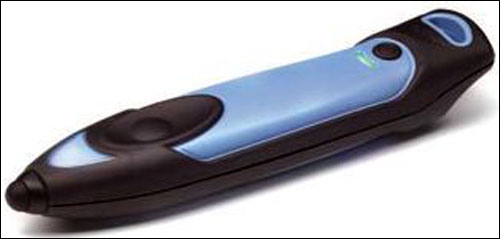Mar 19, 2012California-based auto glass wholesaler Mygrant Glass is eliminating the need for paperwork for delivery verification, by equipping its drivers with mobile RFID interrogators provided by IDBlue, that read passive EPC Gen 2 ultrahigh-frequency (UHF) RFID tags on the products being delivered, and then forward that information to Apple iPads. The readers can not only transmit to mobile phones and tablets via a Bluetooth connection, but also act as stylus pens, enabling customers to sign for the receipt of products, and thereby creating an electronic receipt.
Mygrant Glass has been deploying the RFID solution in two phases, in order to track glass inventory within its distribution centers, as well as at the point of delivery. Approximately four years ago, the company first began investigating how RFID tags attached to its products could be used to help manage inventory as the goods entered and exited each of 60 DCs. Three years ago, says Daniel Parkinson, Mygrant Glass' IT director, the firm began applying UPM RFID ShortDipole tags manufactured with Impinj Monza 4 chips. Workers at the DCs employ Convergence Systems Limited (CSL) CS101 handhelds to read the tags and record the products' receipt, storage and loading onto delivery trucks, and to then forward that data to Mygrant Glass' own software system.
The second phase of the project, however, involved utilizing the tags to verify the receipt of particular products by customers. In this case, Mygrant wanted to improve the accuracy of data regarding which items were provided to each customer, and to save the cost of paper that was printed and signed by customers and later input into the system. Without the RFID solution, the company typically prints 15,000 paper receipts annually.
Mygrant worked with some RFID hardware vendors in Asia, Parkinson says, but failed to find a reader that could accomplish a short read range with the UHF tags. The short range was important, he notes, in order to ensure that specific tags (those on products being sold to a particular customer) were read, while other tags (those destined for a different customer, for example) were not. Although CSL CS101 handhelds performed well for tracking inventory in the DCs, their read range was too long for the customer-delivery application, Parkinson explains.
Mygrant learned that IDBlue was developing a short-range UHF reader for "precision RFID reads" that could interrogate tags at a distance of about 3 to 5 centimeters (1.2 inches to 2 inches)—while not reading other tags within the vicinity that are beyond that range—and then use a Bluetooth connection to transmit the read data to a mobile computer or a smartphone. The firm's delivery-truck drivers tested approximately 12 of the readers at a DC in Hayward, Calif., earlier this year. This month the company began rolling out the system to all 60 sites, equipping drivers of its fleet of 570 vehicles with iPads and IDBlue readers.
The complete rollout of the system to all drivers is expected to be completed at the end of 2012. Once the solution is fully in use, Parkinson says, the company expects to save "hundreds of thousands [of dollars] by not using paper, storing paper or searching for paperwork." The electronic RFID-based system will reduce the incidence of errors, he predicts, since most mistakes occur when data is manually handwritten onto the paperwork, or transcribed into the system at the office once delivery is complete.
IDBlue has been marketing a high-frequency (HF) version of its pen-shaped reader since early 2011, according to Steve Taylor, the company's CEO. "We designed the product to fill a gap in the suite of technologies out there," he says. The UHF version was released at the end of last year. Other UHF readers, he adds, tend to be fixed, and are used for long-range reading, while NFC or HF models are utilized for short-range applications. The purpose of IDBlue's HF and UHF readers is to enable short-range reading for such applications as product deliveries or asset inspections, and to reduce costs by enabling users to store data on their existing mobile device (phone or tablet) and send it to a back-end system. The readers—which can be carried in a pocket, worn around the neck on a lanyard, or stored in a toolbox—are designed to be rugged, with a thermoplastic elastomer (TPR) coating similar to what is found on a hammer's handle, in order to protect them from heavy impacts or other environmental damage.
Taylor says customers in North America, Asia, Europe and Australia are currently using the readers in the retail, health-care, construction, oil and gas, and pharmaceutical industries. The UHF version costs $599, while the HF model is priced at $499. IDBlue's goal, he says, was to offer a solution that would cost a customer less than $1,000 for an entire RFID system, including the reader, any necessary software and tags.



